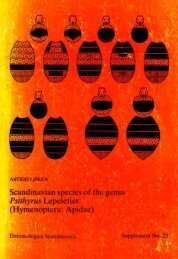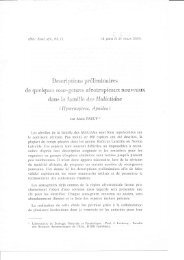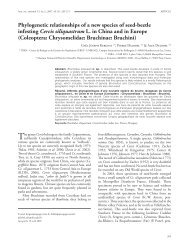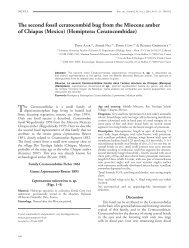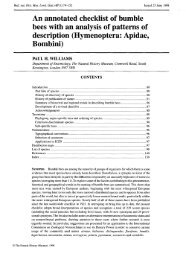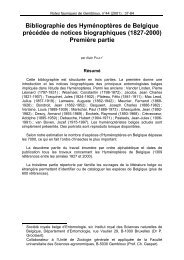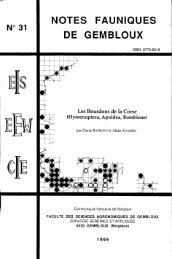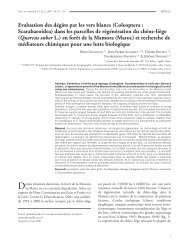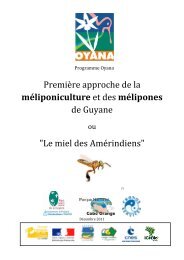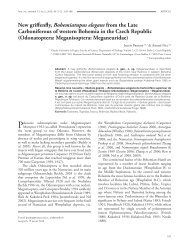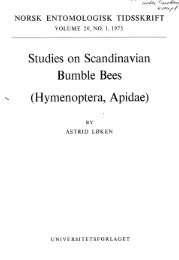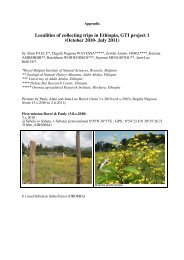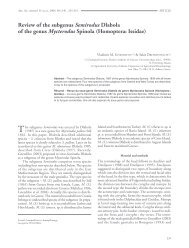Bologna 2009 - Beetles and Rock Art in Libya - Free
Bologna 2009 - Beetles and Rock Art in Libya - Free
Bologna 2009 - Beetles and Rock Art in Libya - Free
Create successful ePaper yourself
Turn your PDF publications into a flip-book with our unique Google optimized e-Paper software.
<strong>Libya</strong>n Meloidae<br />
Distribution. Trans-Saharan species, widely distributed<br />
from Morocco east to Egypt, Israel, Iraq <strong>and</strong> Saudi<br />
Arabia; south <strong>in</strong>to the Sahelian zones of Senegal,<br />
Gambia, Mauritania, Sudan, Ethiopia <strong>and</strong> Yemen.<br />
<strong>Libya</strong>n records. <strong>Libya</strong> (Kuz<strong>in</strong> 1954). Tripolitania. Tarabulus<br />
(<strong>Bologna</strong> & Coco 1991); 5 km West of Al Aziziyah, 9.V.2003<br />
J.C. R<strong>in</strong>genbach coll. 11 exx. (C. R<strong>in</strong>genbach); Al Aziziyah,<br />
14.V.2005 P. Weill coll. 5 exx. (C. Weill); Shakshuk, 21.V.2004<br />
J.C. R<strong>in</strong>genbach coll. 15 exx. (C. R<strong>in</strong>genbach). Fazzan. Brach,<br />
Wadi Jizzah, 10.VI.1982 1 ex. (BMNH; <strong>Bologna</strong> & Coco<br />
1991)<br />
Hycleus aegyptiacus (Marseul 1870)<br />
Mylabris aegyptiaca Marseul 1870: 142.<br />
Distribution. South-eastern sub-Mediterranean<br />
species, recorded from Egypt <strong>and</strong> Cyrenaica.<br />
<strong>Libya</strong>n records. Cyrenaica. Bardiya (Gridelli 1930; Zavattari<br />
1934).<br />
Hycleus apicipennis (Reiche 1866)<br />
Mylabris apicipennis Reiche 1866: 635<br />
Distribution. Eastern sub-Mediterranean species, recorded<br />
from Israel <strong>and</strong> Palest<strong>in</strong>e, S<strong>in</strong>ai, <strong>and</strong> Egypt. Not<br />
currently known <strong>in</strong> <strong>Libya</strong>, but suspected to occur there.<br />
<strong>Libya</strong>n records. Re-exam<strong>in</strong>ation of the specimen of this species<br />
preserved at IAO, which was listed by Beccari & Ger<strong>in</strong>i (1979)<br />
as from “<strong>Libya</strong>”, clearly <strong>in</strong>dicates the Egyptian locality “Sakkara”<br />
(see Alosimus syriacus <strong>and</strong> Hycleus brunnipes). The presence of<br />
this species <strong>in</strong> <strong>Libya</strong> is not yet confirmed.<br />
Remarks. The aff<strong>in</strong>ities of this species, which belongs<br />
to the group of H. bimaculatus (Olivier 1811), were<br />
discussed by <strong>Bologna</strong> & Turco (2007).<br />
Hycleus argentifer argentifer (Pic 1895)<br />
Zonabris argentifer Pic 1895: 81<br />
Mylabris (Decatoma) henoni Fairmaire 1897: 121<br />
Distribution. Trans-Saharan polytypic species, recorded<br />
from Morocco, East to Saudi Arabia <strong>and</strong> Israel. The<br />
subspecies is ma<strong>in</strong>ly distributed <strong>in</strong> the Sahara.<br />
<strong>Libya</strong>n records. <strong>Libya</strong> (<strong>Bologna</strong> & Turco 2007). Tripolitania.<br />
Sabratah, 27.VIII.2005 <strong>and</strong> 17.IX.2005, P. Weill coll. 11 exx.<br />
(C. Weill); Gharyan, 4.VI.2004 J. C. R<strong>in</strong>genbach coll. 1 ex. (C.<br />
R<strong>in</strong>genbach); Janzur, 3.VIII.2002 J. C. R<strong>in</strong>genbach coll. 1 ex.<br />
(C. R<strong>in</strong>genbach).<br />
Remarks. The aff<strong>in</strong>ities of this species, which belongs<br />
to the group of H. octodecimmaculatus (Marseul 1870),<br />
were discussed by <strong>Bologna</strong> & Turco (2007).<br />
? Hycleus brevicollis (Baudi 1878)<br />
Mylabris brevicollis Baudi 1878: 373<br />
Distribution. West Mediterranean species, distributed<br />
with cont<strong>in</strong>uity from Morocco to southern Tunisia<br />
(<strong>Bologna</strong> 1991), while the record from southern Spa<strong>in</strong><br />
(Capo de Gata, Almeria) represents a relict population<br />
(Ruiz et al. 1994). Old records from coastal provence<br />
(France) <strong>and</strong> western Liguria (Italy) are uncerta<strong>in</strong> (see<br />
<strong>Bologna</strong> 1991). Not currently known <strong>in</strong> <strong>Libya</strong>, but<br />
suspected to occur there.<br />
<strong>Libya</strong>n records. <strong>Libya</strong> (<strong>Bologna</strong> 2008). Cyrenaica. Gridelli<br />
(1930) cited one specimen from Benghazi as close to brevicollis.<br />
This specimen, preserved <strong>in</strong> the former Italian Royal Agriculture<br />
Office of Benghazi, was not exam<strong>in</strong>ed <strong>and</strong> may be lost. The<br />
presence of a western Mediterranean species <strong>in</strong> Cyrenaica needs<br />
confirmation; this specimen was likely misidentified.<br />
Hycleus brunnipes (Klug 1845)<br />
Mylabris brunnipes Klug 1845: 32<br />
Distribution. Trans-Saharan species, distributed from<br />
Morocco East to the Arabian Pen<strong>in</strong>sula <strong>and</strong> Israel.<br />
New for <strong>Libya</strong>.<br />
<strong>Libya</strong>n records. Fazzan. Murzuq, Edeyen, 9.IV.2003 J.-<br />
C. R<strong>in</strong>genbach coll. 3 exx. (C. R<strong>in</strong>genbach). Recently, I reexam<strong>in</strong>ed<br />
the specimen of this species preserved at the IAO,<br />
which was listed by Beccari & Ger<strong>in</strong>i (1979) as “<strong>Libya</strong>”. The<br />
label is illegible, but possibly refers to “Sakkara” an Egyptian<br />
locality (see Alosimus syriacus <strong>and</strong> Hycleus brunnipes).<br />
Remarks. The aff<strong>in</strong>ities of this species to a Saharo-<br />
S<strong>in</strong>dian group were discussed by <strong>Bologna</strong> & Turco<br />
(2007).<br />
Hycleus ocellaris (Olivier 1795)<br />
Cerocoma ocellaris Olivier 1795: 6<br />
Distribution. Species with uncerta<strong>in</strong> distribution, recorded<br />
from Senegal, Gu<strong>in</strong>ea, Eritrea, Egypt <strong>and</strong> <strong>Libya</strong>.<br />
Some Sahelian records may refer to other species of the<br />
same group, such as H. argentatus (Fabricius, 1792).<br />
<strong>Libya</strong>n records. Cyrenaica. Bardiya (Gridelli 1930; Zavattari<br />
1934).<br />
Remarks. This species belongs to an Afrotropical group<br />
as discussed by Pardo Alcaide (1963), <strong>Bologna</strong> (1991),<br />
<strong>and</strong> <strong>Bologna</strong> & Turco (2007).<br />
Hycleus octodecimmaculatus (Marseul 1870)<br />
Mylabris octodecimmaculata Marseul 1870: 147<br />
Zonabris mela<strong>in</strong>i Escalera 1909: 249<br />
Distribution. Trans-Saharan species, widely distributed<br />
from Morocco to Egypt <strong>and</strong> Israel.<br />
<strong>Libya</strong>n records. Cyrenaica. Benghazi 2 exx. (MZUB; Zanon<br />
1922b; Cros 1928; Gridelli 1930; Zavattari 1934).<br />
Remarks. The aff<strong>in</strong>ities of this species were discussed<br />
by <strong>Bologna</strong> & Turco (2007).<br />
Hycleus r<strong>in</strong>genbachi n. sp.<br />
Type material. Holotype ♀, with the follow<strong>in</strong>g labels: “<strong>Libya</strong>,<br />
Tripolitania, Janzur, 03.viii,2002, J.-C. R<strong>in</strong>genbach” (both<br />
white, pr<strong>in</strong>ted); Holotypus ♀, Hycleus r<strong>in</strong>genbachi n.sp.,<br />
351



